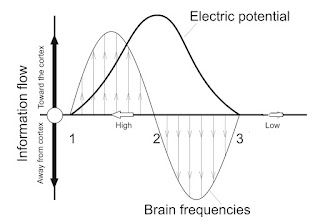Трево́га — отрицательно окрашенная эмоция, выражающая ощущение неопределённости, трудноопределимые предчувствия. В отличие от причин страха, причины тревоги обычно не осознаются, но она предотвращает участие человека в потенциально вредном поведении, или побуждает его к действиям по повышению вероятности благополучного исхода событий. Тревога связана с подсознательной мобилизацией психических сил организма для преодоления потенциально опасной ситуации.
Содержание
Например, при айхмофобии человек старается всеми силами избегать острых предметов, которыми он боится пораниться или поранить других людей. В случае развития аквафобии он боится плавать, а при клаустрофобии поднимается вверх исключительно по лестнице, так как ему страшно находиться в закрытом лифте. Фобию относительно легко можно победить в начале её возникновения, но она может закрепляться в психике человека и усиливаться со временем.
В психоанализе фобией также считается навязчивый невроз, при котором тревога становится ведущим и мотивирующим поведение симптомом. В данном смысле фобия понимается как синоним фобической болезни или тревожной истерии.
В специальном, медицинско-психиатрическом смысле слова только очень небольшая часть из приведённых ниже терминов может быть названа фобией как «клиническим состоянием, требующим психологической коррекции». В частности, если страх выходит из-под контроля человека и препятствует его нормальной жизнедеятельности, то тогда может быть поставлен диагноз панического расстройства[1][2] либо специфической фобии.
Для выявления фобического расстройства часто используют тест на тревогу и фобии, так называемую шкалу Занга для самооценки тревоги[3].
Фо́бия (от греч. φόβος «страх»), боя́знь — симптом, сутью которого является иррациональный неконтролируемый страх или устойчивое переживание излишней тревоги в определённых ситуациях или в присутствии (ожидании) некоего известного объекта.
В психиатрии фобией принято называть патологически повышенное проявление реакции страха на тот или иной раздражитель. Фобия — это сильно выраженный упорный навязчивый страх, необратимо обостряющийся в определённых ситуациях и не поддающийся полному логическому объяснению. В результате развития фобии человек начинает бояться и соответственно избегать определенных объектов, видов деятельности или ситуаций.
Содержание
![[pic]](https://ic.pics.livejournal.com/metanymous/1177339/131006/131006_600.jpg)
Страх, фобия, тревога, ПостТравматическое Стрессовое Расстройство (ПТСР) (3) Уточнение соотношений
metanymous в Metapractice (оригинал в ЖЖ)
Как в НЛП различаются тревога, страх, фобия?
Есть техника быстрой лечении фобий, а есть ли техника быстрого лечения тревоги?
Или тревога - имеет какой-то дополнительный шаг, которого нет при фобии?
https://metapractice.livejournal.com/559998.html?thread=14414974#t14414974

https://metapractice.ru/images/0/0f/%D0%A1%D1%82%D1%80%D0%B0%D1%85%2C_%D1%82%D1%80%D0%B5%D0%B2%D0%BE%D0%B3%D0%B0%2C_%D0%BF%D0%B0%D0%BD%D0%B8%D0%BA%D0%B0%2C_%D1%84%D0%BE%D0%B1%D0%B8%D1%84%2C_%D0%9F%D0%9F%D0%A2%D0%A1.pptx
http://ljsearch.metapractice.ru/
![[pic]](https://2.bp.blogspot.com/-7O0tJsvKvqM/WIDkkvwW2iI/AAAAAAAABM0/tb6dC5N5ljkMTvmTU-G7rswg0kKrbUj9ACLcB/s320/Brain_frequencies1.jpg)
Модел. эмоции (26) Нейрологическая "энергетическая" компонента модели
metanymous в Metapractice (оригинал в ЖЖ)
http://evadeli.blogspot.com/2017/01/emotions-energy-states-of-brain.html
Emotions, the energy states of the brain

The great predictive power of Newton's Principia made it the accepted description of gravity for over three centuries. However, Einstein's general relativity uncovered a deeper origin of gravity, the geometry of the spatial field, an invisible entity that only can be measured indirectly, by its effects. Consciousness evolved in interaction with the material world, which engendered a brain organization and operation that mirrors the physical world. Although consciousness shows a temporal organization, emotional interactions occur via field effects. This temporal field, which underlies mental-social interaction, has definite energy-information value at every moment of time. Thus, the mind is a self-regulating system, operating according to its energy states and imbalances (commonly known as emotions), which guides attention, memory and behavior. Because the temporal field is analogue to the field of gravity, it regulates the mental state via its entropy. Changes in this field leads to powerful emotional reactions, such as shame, pride, joy and others. This way, emotions underlie all cognitive processes, including perception, memory, thoughts and behavior. We do not have to be conscious of emotions to be regulated and influenced by them. Evidence for this temporal field in the brain's operation has been measured recently Peters and colleagues (2016).
Sensory perception is automatic, involuntary process. We cannot ‘decide’ not to process sensory stimulus or read the road signs, because stimulus impinges on the mind by shifting the brain’s energy balance. Moreover, sensory perception is an energy requiring and active process, in which the brain ‘pays’ for sensory stimuli through the energy requirement of high brain frequencies. Thus, sensory processing is an energy-information exchange with the environment. The limbic system channels incoming stimuli (information), as fast oscillations, to the sensory cortex, where electric currents accentuate or subdue each other through field effects. The brain’s highly fluid neural organization allows fast balancing of electromagnetic gradients based on charge conservation. From the sensory cortical surface the oscillations propagate toward the frontal associative regions. As the energy requirement of neuronal activation gradually extinguishes the information flow, it gives rise to an electric potential difference between the limbic and cortical areas, which reverses the flow via slow oscillations (Figure above, #2). The information flow reversal from the frontal toward occipital direction, and back toward the limbic region recovers the energy neutral state. The sensory transmission toward the sensory cortex by fast oscillations and response by slow oscillations was confirmed by Buzsaki (2013), indicating the polarity effects of the brain's electromagnetic flows. My sincere hope is that within five years computer simulations based on EEG, fMRI and other techniques will be able to pinpoint the tendency for unhealthy emotional states (i.e., the brain's energy balance) in patients and predict proneness for depression, PTSD (post traumatic stress disorder), anxiety and other conditions. You can find more detailed information in my book, The science of consciousness, or manuscript, Consciousness, a Cosmic Phenomenon.
Дочитали до конца.
